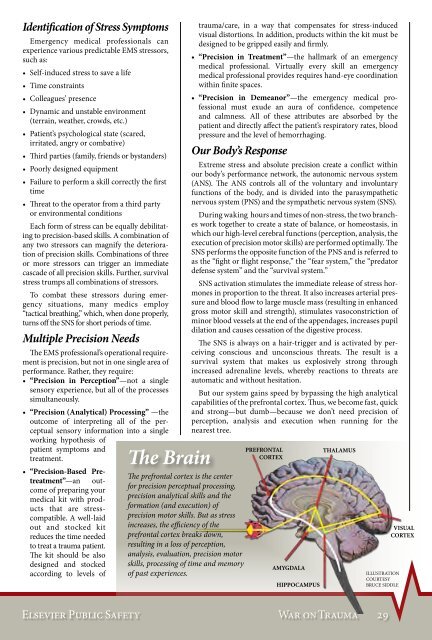Lessons Learned from a Decade of Conflict - Boekje Pienter
Lessons Learned from a Decade of Conflict - Boekje Pienter
Lessons Learned from a Decade of Conflict - Boekje Pienter
You also want an ePaper? Increase the reach of your titles
YUMPU automatically turns print PDFs into web optimized ePapers that Google loves.
Identification <strong>of</strong> Stress SymptomsEmergency medical pr<strong>of</strong>essionals canexperience various predictable EMS stressors,such as:• Self-induced stress to save a life• Time constraints• Colleagues’ presence• Dynamic and unstable environment(terrain, weather, crowds, etc.)• Patient’s psychological state (scared,irritated, angry or combative)• Third parties (family, friends or bystanders)• Poorly designed equipment• Failure to perform a skill correctly the firsttime• Threat to the operator <strong>from</strong> a third partyor environmental conditionsEach form <strong>of</strong> stress can be equally debilitatingto precision-based skills. A combination <strong>of</strong>any two stressors can magnify the deterioration<strong>of</strong> precision skills. Combinations <strong>of</strong> threeor more stressors can trigger an immediatecascade <strong>of</strong> all precision skills. Further, survivalstress trumps all combinations <strong>of</strong> stressors.To combat these stressors during emergencysituations, many medics employ“tactical breathing,” which, when done properly,turns <strong>of</strong>f the SNS for short periods <strong>of</strong> time.Multiple Precision NeedsThe EMS pr<strong>of</strong>essional’s operational requirementis precision, but not in one single area <strong>of</strong>performance. Rather, they require:• “Precision in Perception” —not a singlesensory experience, but all <strong>of</strong> the processessimultaneously.• “Precision (Analytical) Processing” —theoutcome <strong>of</strong> interpreting all <strong>of</strong> the perceptualsensory information into a singleworking hypothesis <strong>of</strong>patient symptoms andtreatment.• “Precision-Based Pretreatment”—anoutcome<strong>of</strong> preparing yourmedical kit with productsthat are stresscompatible.A well-laidout and stocked kitreduces the time neededto treat a trauma patient.The kit should be alsodesigned and stockedaccording to levels <strong>of</strong>The Braintrauma/care, in a way that compensates for stress-inducedvisual distortions. In addition, products within the kit must bedesigned to be gripped easily and firmly.• “Precision in Treatment” —the hallmark <strong>of</strong> an emergencymedical pr<strong>of</strong>essional. Virtually every skill an emergencymedical pr<strong>of</strong>essional provides requires hand-eye coordinationwithin finite spaces.• “Precision in Demeanor” —the emergency medical pr<strong>of</strong>essionalmust exude an aura <strong>of</strong> confidence, competenceand calmness. All <strong>of</strong> these attributes are absorbed by thepatient and directly affect the patient’s respiratory rates, bloodpressure and the level <strong>of</strong> hemorrhaging.Our Body’s ResponseThe prefrontal cortex is the centerfor precision perceptual processing,precision analytical skills and theformation (and execution) <strong>of</strong>precision motor skills. But as stressincreases, the efficiency <strong>of</strong> theprefrontal cortex breaks down,resulting in a loss <strong>of</strong> perception,analysis, evaluation, precision motorskills, processing <strong>of</strong> time and memory<strong>of</strong> past experiences.Extreme stress and absolute precision create a conflict withinour body’s performance network, the autonomic nervous system(ANS). The ANS controls all <strong>of</strong> the voluntary and involuntaryfunctions <strong>of</strong> the body, and is divided into the parasympatheticnervous system (PNS) and the sympathetic nervous system (SNS).During waking hours and times <strong>of</strong> non-stress, the two brancheswork together to create a state <strong>of</strong> balance, or homeostasis, inwhich our high-level cerebral functions (perception, analysis, theexecution <strong>of</strong> precision motor skills) are performed optimally. TheSNS performs the opposite function <strong>of</strong> the PNS and is referred toas the “fight or flight response,” the “fear system,” the “predatordefense system” and the “survival system.”SNS activation stimulates the immediate release <strong>of</strong> stress hormonesin proportion to the threat. It also increases arterial pressureand blood flow to large muscle mass (resulting in enhancedgross motor skill and strength), stimulates vasoconstriction <strong>of</strong>minor blood vessels at the end <strong>of</strong> the appendages, increases pupildilation and causes cessation <strong>of</strong> the digestive process.The SNS is always on a hair-trigger and is activated by perceivingconscious and unconscious threats. The result is asurvival system that makes us explosively strong throughincreased adrenaline levels, whereby reactions to threats areautomatic and without hesitation.But our system gains speed by bypassing the high analyticalcapabilities <strong>of</strong> the prefrontal cortex. Thus, we become fast, quickand strong—but dumb—because we don’t need precision <strong>of</strong>perception, analysis and execution when running for thenearest tree.ILLUSTRATIONCOURTESYBRUCE SIDDLEElsevier Public Safety War on Trauma 29
















